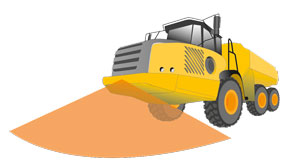KANBrief 4/14

A warning will shortly be published in the EU Official Journal concerning the EN 474-1 standard governing the safety of earthmoving machinery (published in the Official Journal of 8 January 2015). As a result, the standard will no longer give rise to a presumption of conformity with the requirements of the Machinery Directive concerning visibility from the operator's seat. At the same time, agreement has been reached to prepare an interim amendment to ISO 5006 (Earth-moving machinery – Operator's field of view) in response to a proposal by the European market surveillance authorities.
Poor visibility is frequently a cause of serious accidents involving earthmoving machinery. In response to two petitions to the European Parliament drawing attention to this fact, the European Commission has launched a formal objection to EN 474-1, Earth-moving machinery – Safety – Part 1: General requirements. The objection had majority support in the responsible committees of the European Commission, namely the Machinery Working Group and the Committee on Standards. The standard is considered inadequate for supporting the requirements of the Machinery Directive, Annex I, Points 1.2.2 (visibility of the danger zones during starting) and 3.2.1 (visibility during operation), since it governs visibility conditions by reference to inadequate requirements in ISO 5006.
Consequences of loss of the presumption of conformity
Manufacturers have an obligation to design their machines in compliance with the relevant requirements of the Machinery Directive. Should they use harmonized standards for this purpose, reference to compliance with these standards is sufficient to demonstrate satisfaction of the requirements covered by the standards. Owing to the warning in the Official Journal, EN 474-1 no longer gives rise to this presumption of conformity with regard to the visibility requirements. Satisfaction of the corresponding provision in the standard is thus no longer sufficient to demonstrate that the machine complies in this respect with the Machinery Directive. Manufacturers are nevertheless obviously still obliged to ensure that the design of the machines placed on the market assures good visibility for the operator and that the requirements of the directive referred to above are therefore satisfied. They must therefore now also state in detail in their technical documentation how risk assessment has been performed and the steps taken to comply with the visibility requirements.
Activity in the standards committees
At the beginning of 2014, the Administrative Co-operation Working Group (ADCO) of the European market surveillance authorities called upon CEN and ISO to revise ISO 5006, Earthmoving machinery – Operator's field of view – Test method and performance criteria, at the earliest opportunity. ADCO listed five points which should be included in the standard in the first instance:
• Priority must always be given to direct visibility.
• Close-range visibility must be improved by reduction of the height of the test body from 1.5 m to 1.0 m.
• Visual aids such as CCTV systems and mirrors must be fitted in the forward direction of view.
• Visual aids must not be obstructed by moving parts of the machinery (such as excavator arms).
• Mirror-to-mirror systems are not permissible.
The responsible ISO committee has taken up these proposals and aims to incorporate the five points of the ADCO paper into ISO 5006. Publication of the amended standard is anticipated at the end of 2015. At the same time, a reference to the amended version of ISO 5006 is to be added to EN 474-1.
Future prospects
If the provisions of ISO 5006 are amended as described, this would constitute a major step forwards in improving the visibility conditions for earthmoving machinery placed on the market for the first time. It is anticipated that the warning in the Official Journal concerning EN 474-1 can be deleted again once all the points listed have been incorporated.
It should be noted that these standardization steps were expedited by the discussion concerning limitation of the presumption of conformity to which EN 474-1 gives rise. Far-reaching revision of ISO 5006 was postponed in the interests of a swift amendment, and is to resume once the amendment has been published. In the future, ISO 5006 is to take the form of an EN ISO standard under the Vienna Agreement. At European level, all 12 parts of the EN 474 series of standards, Earth-moving machinery – Safety, are currently being revised. These standardization projects all require the active support of the stakeholders.
Dr Michael Thierbach
thierbach@kan.de